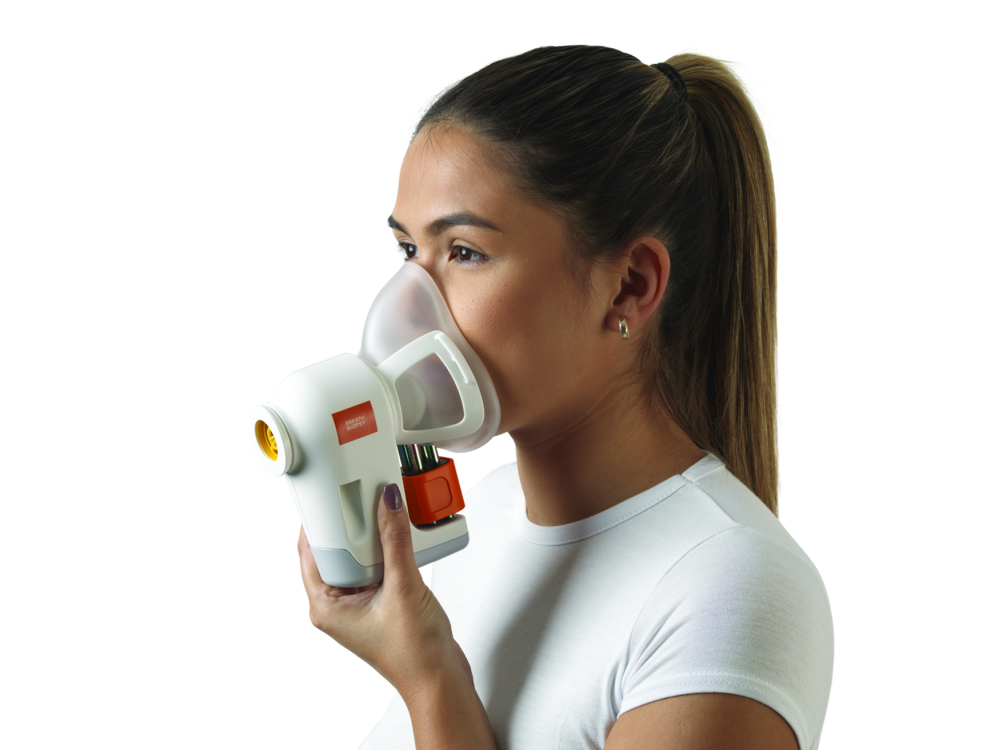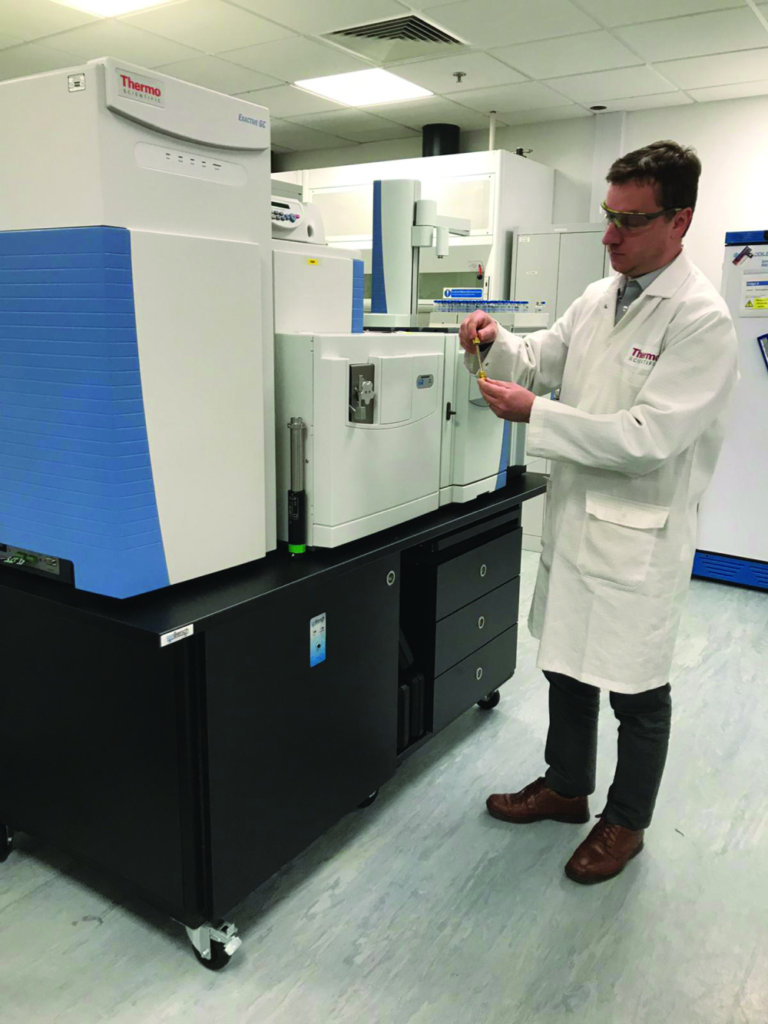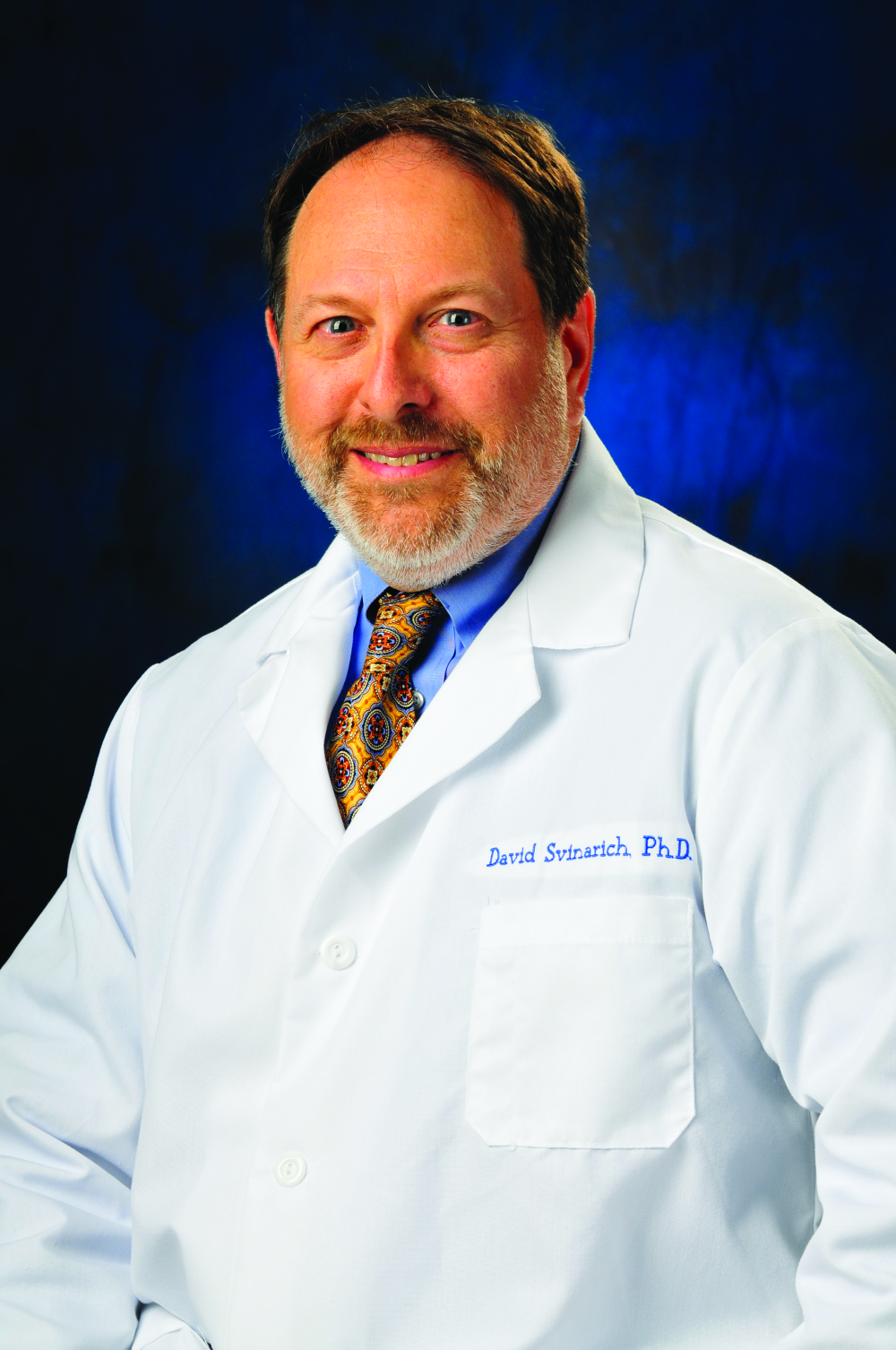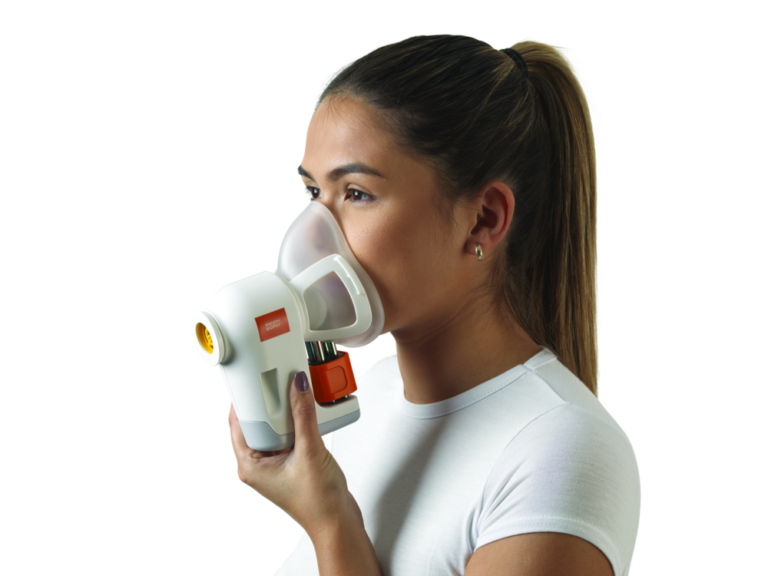Technology that analyzes VOCs in exhaled air could offer early detection of some respiratory illnesses including COVID-19, as well as cancers, immune disorders
Your breath gives away a lot of information. Besides betraying that you’ve had garlic or onions for lunch, it also contains volatile organic compounds (VOCs) that provide quite telling biomarkers of disease. Building on the potential capability of VOCs to detect illness, the U.K. company Owlstone Medical is now developing a testing platform called Breath Biopsy [1] as a noninvasive diagnostic method and is collaborating with clinicians, researchers, and other biomedical companies around the world on its potential application for early detection of various cancers, respiratory illnesses, and immune diseases.
The connection between VOCs and health has a long history, dating as far back as Hippocrates who observed that patients with certain diseases had particular odors, according to Marc van der Schee, Ph.D., head of clinical at Owlstone Medical (Figure 1). Dogs have even been trained to key in on VOCs that reveal a low blood-sugar level in people with diabetes or early-stage Parkinson’s disease, and studies are now under way to see if they can be trained to detect individuals infected with COVID-19 [2]. He explained, “These VOCs are effectively metabolites, so they are the breakdown products of the activity of your cells and the microbes that live in your body, and they also reflect the exposures you have in your environment, [so] your breath is really a very rich source of data,” he explained.

While blood, urine, and stool tests have become commonplace ways to identify illnesses, however, the development of breath tests has lagged and the primary reason is “there was no reliable way to collect a breath sample and to analyze it,” van der Schee said. With Breath Biopsy, Owlstone Medical is leaping those hurdles with its standardized sample collection and its analysis technologies.
Collecting and analyzing
To develop the breath sampler, Owlstone Medical consulted other breath-research experts so it had a good picture of everything an ideal sampler should do, and then set out to build it, van der Schee said. “Then our engineers started developing prototypes, and over the space of about a year, we were able to mature this to the point where we were able to launch the first version of this device.” Called the ReCIVA Breath Sampler, the device is a handheld mask that fits over the mouth and nose as the patient simply breathes in and out (Figure 2).

The mask delivers a controlled supply of air to inhale, and the exhaled breath is captured and stabilized. Whereas blood samples go into small collection tubes called vacutainers, breath samples go into specially designed cartridges, he described. “The cartridge is like a vacutainer for the breath, so just as vacutainers standardized the collection and storage of blood samples about 30 years ago, and helped the whole area of blood diagnostics to take off, we now have this standardized and reliable sampling methodology for breath, so we can ship the samples to our lab for analysis.”
Analysis involves identifying and quantifying the range of VOCs in the breath samples and for this, Owlstone Medical has a strategic partnership with Thermo Fisher Scientific of Waltham, MA [3], about using its GC Orbitrap high-resolution gas chromatography–mass spectrometry (GC–MS) technology (Figure 3).
Thermo Fisher designed and has been using the GC Orbitrap for food-safety, environmental monitoring, and some metabolomics applications, and was excited to try scanning breath samples for VOCs, recalled Cristian Cojocariu, Ph.D., GC/GC–MS applications manager for Thermo Fisher Scientific. “An important aspect of collecting VOCs in breath is that you are dealing with compounds of very low concentrations—in the parts-per-trillion range—all the way to compounds up to parts-per-million—really high concentrations—and we had to be able to detect, identify, and quantify these compounds at both low and high concentrations very accurately,” he said.
The GC Orbitrap is not only able to detect the full range of VOC concentrations but also when used in combination with the Thermo Fisher Scientific’s Chromeleon chromatography data system, it is also assisting with biomarker quantification and identification, Cojocariu said. “The data processing for this application is a two-fold process: One part involves targeting and quantifying the VOCs that we know are linked—or are good candidates to be linked—to diseases. The other part involves untargeted metabolomics, where we analyze all the compounds in diseased patients and in control/healthy patients, compare the data to look for differences in the VOC profiles, and then identify those VOCs that are enhanced or suppressed in the healthy versus diseased data.”
Additionally, Owlstone Medical has developed a high field asymmetric waveform ion mobility spectrometry (FAIMS) chip, which van der Schee portrayed as “basically a miniaturized version of a spectrometer that can be functionalized to look for the target compounds of interest in a miniaturized form factor” [4]. He added, “As such, FAIMS could be ideal for point-of-care use in clinical settings.”

From data to diagnostics
Owlstone Medical is compiling data like those from the GC Orbitrap system so that it can begin to identify and verify those biomarkers that can serve as reliable indicators of disease. The company also is running several of its own investigations, as well as developing parallel collaborative projects with research groups and pharmaceutical organizations to find biomarkers for specific diseases. Cleveland Clinic, for example, announced a partnership with Owlstone Medical last fall that will study breath VOCs as a way to detect liver disease early on, when treatments can have a greater effect. The 12-month study will look at VOCs in patients with hepatocellular carcinoma, colorectal liver metastases, or cirrhosis but no malignancies in an attempt to find useful biomarkers that can detect early cancer and help distinguish between different types of liver disease [5].
Ascension Michigan, a health care system headquartered in Warren, MI, has also partnered with Owlstone Medical to investigate breath VOCs as biomarkers for mesothelioma [6]. “Mesothelioma is somewhat like pancreatic cancer in that by the time it manifests itself, the clinical course is pretty far along and there’s not necessarily a lot that can be done therapeutically. So part of the motivation in looking at this methodology comes out of frustration because there really are no good diagnostic strategies to detect mesothelioma at an early clinical stage,” said David Svinarich, Ph.D., vice president of research at Ascension Michigan (Figure 4).
Svinarich and Michael Harbut, MD, an occupational medicine specialist at Ascension Michigan, are heading the two-part study, which is supported in part by the Insulators Tissue Bank and Asbestos Research Fund. The first phase, which started last summer, focuses on determining the VOC profile of exhaled breath from subjects with histologically confirmed mesothelioma and comparing it to a control population of individuals who do not have mesothelioma but do have some degree of lung involvement, such as fibrotic disease or pleural plaques. “We did this rather than using completely healthy controls, because in order to help these people out, we will ultimately have to distinguish between the two groups,” Svinarich said. The main task from this phase is to obtain enough preliminary data to find good candidate biomarkers “and preferably several because your predictive capability—your sensitivity and your specificity—go up when you have multiple markers to look at,” he explained.

Once the first phase is completed, a blind-study phase will follow to determine whether the biomarkers can indeed reliably diagnose mesothelioma. Svinarich anticipates that the second phase will be completed by 2022. Although still early in the study, he is optimistic about Breath Biopsy for mesothelioma. “The fundamental idea has merit, and there’s been enough ancillary data from other diseases and other studies to suggest that it may work,” he remarked. “The whole intent behind this is to have in our armamentarium a diagnostic tool that is cheap, easy to do, effective and noninvasive, so we can identify individuals who have early-stage mesothelioma or will go on to develop disease. This will allow us to intervene therapeutically at a point when we can affect the outcome, or the course of that disease, because as I said, the big problem now is that by the time people develop this and symptoms manifest, your therapeutic options are limited.”
Interpreting the data
In the mesothelioma work and in other breath-analysis projects, van der Schee said one of the big challenges in the field is understanding more about exhaled biomarkers. This includes determining biomarker origins, and whether they are endogenous and generated within the body, or exogenous (e.g., a lingering odor compound from toothpaste or food), as well as what the biomarkers reveal about health and disease.
“Almost serendipitously, for instance, it was found that a molecule called limonene, which is very prevalent in citrus fruits, is something that is broken down by the liver, but if your liver is not functioning well, it doesn’t break it down,” he said. Consequently, breath analysis showed “massively elevated levels” of limonene in patients with liver cirrhosis. In this case, limonene may be an exogenous compound, he said, but is also a biomarker for disease, and the company is now pursuing the development of “exogenous VOC” probes (EVOC Probes), to pursue metabolic pathways of interest [7].
Such simple breath-test probes could be used by general practitioners or pharmacists to quickly and inexpensively check a person’s breath for signs of certain diseases, and possibly even in conjunction with annual or biennial checkups to determine an individual’s risk for disease through identification of exposure to hazardous exogenous compounds, such as those present in cigarette smoke or other pollutants that increase the risk of disease.
The company is collaborating on a wide range of studies to test VOCs as biomarkers for disease, with a focus on early detection of a range of cancers including lung cancer, colorectal cancer, and liver cancer which includes a collaboration with Cancer Research U.K.
Outside of cancer, Owlstone Medical is also investigating Breath Biopsy for other applications. For instance, it is working on the characterization of asthma as a way to give clinicians more guidance in making optimal treatment choices for each patient; and it has also joined 3TR, a large-scale, multicenter and multicountry research initiative, to study Breath Biopsy’s application for immune diseases ranging from systemic lupus erythematosus and multiple sclerosis to rheumatoid arthritis, inflammatory bowel disease, various liver diseases, asthma, and chronic obstructive pulmonary disease [8]; as well as the EU-funded Exposome Project for Health and Occupational Research, which aims to improve understanding of the complex relationships between environment and disease [9].
At this point, van der Schee said breath analysis is in the biomarker-discovery phase, but is moving forward quickly, with Breath Biopsy tests expected to appear in doctor’s offices in as little as five to six years. He remarked, “For the first time, we’re in a position where we can actually start interpreting these VOC data for larger-scale studies and make significant progress toward evaluating breath as a diagnostic tool.”
References
- Owlstone Medical. Accessed: Apr. 8, 2020. [Online]. Available: https://www.owlstoneinc.com/
- M. Goodavage, “Scientists are studying whether dogs can help sniff out coronavirus,” Salon, Apr. 3, 2020. Accessed: Apr. 9, 2020. [Online]. Available: https://www.salon.com/2020/04/03/scientists-are-studying-whether-dogs-can-help-sniff-out-coronavirus/
- Thermo Fisher Scientific, “Thermo Fisher Scientific collaborates with Owlstone Medical to advance the identification of novel biomarkers: Early disease detection enabled through discovery of biomarkers using non-invasive breath biopsy,” Press release, Nov. 7, 2019. Accessed: Apr. 8, 2020. [Online]. Available: http://thermofisher.mediaroom.com/2019-11-07-Thermo-Fisher-Scientific-Collaborates-with-Owlstone-Medical-to-Advance-the-Identification-of-Novel-Biomarkers
- FAIMS Technology, Owlstone Medical. Accessed: Apr. 8, 2020. [Online]. Available: https://www.owlstonemedical.com/science-technology/faims-technology/
- “Cleveland Clinic, Owlstone Medical establish center for early disease detection,” Clinicalomics.com, Oct. 19, 2019. Accessed: Apr. 8, 2020. [Online]. Available: https://www.clinicalomics.com/topics/molecular-dx-topic/cleveland-clinic-owlstone-medical-establish-center-for-early-disease-detection/
- International Association of Heat and Frost Insulators, “Owlstone Medical and the International Association of Heat and Frost Insulators and Allied Workers partner to identify breath biomarkers for the early detection of malignant mesothelioma,” Press release, Jun. 4, 2019. Accessed: Apr. 8, 2020. [Online]. Available: https://www.insulators.org/blog/breath-biomarkers-mesothelioma-study
- E. Gaude et al., “Targeted breath analysis: Exogenous volatile organic compounds (EVOC) as metabolic pathway-specific probes,” J. Breath Res., vol. 13, no. 3, p. 032001, May 17, 2019.
- Owlstone Medical, “Owlstone Medical to contribute Breath Biopsy to 3TR, the largest-ever IMI2 immunology project to improve disease management across seven immune-mediated diseases,” Press release, Oct. 29, 2019. Accessed: Apr. 14, 2020. [Online]. Available: https://www.owlstonemedical.com/about/news/2019/oct/29/owlstone-medical-3tr-imi2-immunology-project/
- Owlstone Medical, “Owlstone Medical to join EU-funded EPHOR Consortium to advance occupational health science in order to reduce disease burden from workplace exposure,” Press release, Dec. 10, 2019. Accessed: Apr. 14, 2020. [Online]. Available: https://www.owlstonemedical.com/about/news/2019/dec/10/ephor-consortium-reduce-disease-burden-exposure/



